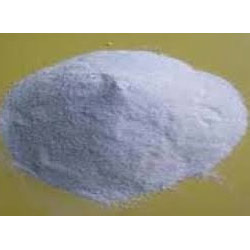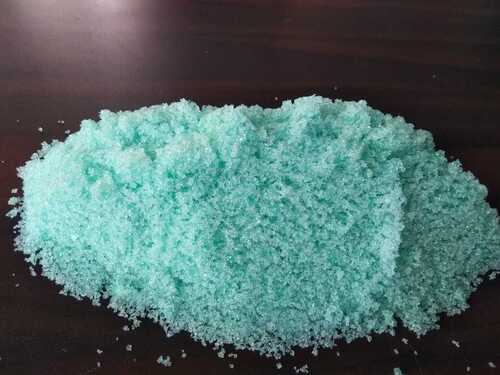Potassium Nitrate
95 INR
Product Details:
- Color White
- Ph Level 6.2
- Grade Technical Grade
- Classification Biological Pesticide
- Product Name Potassium Nitrate
- Molecular Formula KNO3
- Appearance white powder
- Click to View more
X
Potassium Nitrate Price And Quantity
- 1 Kilograms
- 95 INR
Potassium Nitrate Product Specifications
- Potassium Nitrate
- Biological Pesticide
- Granules
- white powder
- KNO3
- Technical Grade
- White
- 6.2
Potassium Nitrate Trade Information
- Cash in Advance (CID), Cheque, Cash Advance (CA)
- 1 Kilograms Ton Per Day
- 1 Week
- Yes
- Free samples are available
- 25 kg or 50 kg bags
- Australia, South America, Western Europe, Middle East, Africa, Asia, Central America, Eastern Europe, North America
- All India
Product Description
Potassium Nitrate BP: KNO3 -- 101.1 -- 7757-79-1
DEFINITION: Potassium nitrate contains not less than 99.0 per cent and not more than the equivalent of 101.0 per cent of KNO3, calculated with reference to the dried substance.
IDENTIFICATION
It gives the reaction of nitrates.Solution S (see Tests) gives the reactions of potassium.
DEFINITION: Potassium nitrate contains not less than 99.0 per cent and not more than the equivalent of 101.0 per cent of KNO3, calculated with reference to the dried substance.
IDENTIFICATION
It gives the reaction of nitrates.Solution S (see Tests) gives the reactions of potassium.
- TESTS Solution S: Dissolve 10.0 g in carbon dioxide-free water prepared from distilled water and dilute to 100 ml with the same solvent.
- Appearance of solution: Solution S is clear and colourless.
- Acidity or alkalinity: To 10 ml of solution S add 0.05 ml of bromothymol blue solution. Not more than 0.5 ml of 0.01 M hydrochloric acid or 0.01 M sodium hydroxide is required to change the colour of the indicator.
- Reducible substances: To 10 ml of solution S, add 0.5 ml of dilute sulphuric acid and 2 ml of zinc iodide and starch solution. The solution does not become blue within 2 min.
- Chlorides: If intended for ophthalmic use, it complies with the test for chlorides. Dissolve 2.5 g in water and dilute to 15 ml with the same solvent. The solution complies with the limit test for chlorides (20 ppm).
- Sulphates: Dilute 10 ml of solution S to 15 ml with distilled water. The solution complies with the limit test for sulphates (150 ppm).
- Ammonium: 1 ml of solution S complies with the limit test (A) for ammonium (100 ppm). If intended for ophthalmic use, not more than 50 ppm of ammonium.
- Calcium: Dilute 10 ml of solution S to 15 ml with distilled water. The solution complies with the limit test for calcium (100 ppm). If intended for ophthalmic use, not more than 50 ppm of calcium.
- Iron: Dilute 5 ml of solution S to 10 ml with water. The solution complies with the limit test for iron (20 ppm). If intended for ophthalmic use, not more than 10 ppm of iron.
- Sodium: Not more than 0.1 per cent of Na, determined by atomic emission spectrometry.
- Heavy metals: 12 ml of solution S complies with limit test A for heavy metals (10 ppm).
- Loss on drying: Not more than 0.5 per cent determined on 1.000 g by drying in an oven at 100°C to 105°C.
Technical Features of Potassium Nitrate
Potassium Nitrate is presented in granules and appears as a white powder, ensuring easy application in various agricultural settings. With a purity tailored for both Agricultural and Industrial use and a technical grade specification, it meets strict quality requirements. Its molecular formula KNO3 and stable pH of 6.2 contribute to its reliability and performance.
Applications in Agriculture and Beyond
This product is classified as a Biological Pesticide and is commonly used as a fertilizer to enhance crop growth, improve resistance to pests, and support soil nutrient balance. Its granulated form simplifies dosing and incorporation into farming routines, as well as broader industrial uses. The distribution network across India ensures timely availability to farmers, traders, and exporters.
FAQs of Potassium Nitrate:
Q: How is Potassium Nitrate used in agriculture?
A: Potassium Nitrate is applied as a fertilizer and biological pesticide to promote plant growth, maintain soil health, and increase crop yields. Its granulated form allows for uniform distribution across fields.Q: What is the primary benefit of using Potassium Nitrate as a biological pesticide?
A: The main benefit is its ability to provide essential nutrients while naturally protecting plants from certain pests, reducing the need for harsh chemical treatments.Q: When should Potassium Nitrate be applied to crops for optimal results?
A: It is recommended to apply Potassium Nitrate during the growing season, particularly at stages when nutrient demand is highest, such as flowering and fruit development.Q: Where is Potassium Nitrate primarily supplied, distributed, and manufactured in India?
A: Potassium Nitrate is widely available throughout India, supplied, exported, imported, and manufactured by various distributors and suppliers for agricultural and industrial use.Q: What process is involved in manufacturing Potassium Nitrate granules?
A: Potassium Nitrate granules are produced through chemical synthesis, followed by purification and granulation to ensure high purity and consistent technical grade quality.Q: How does the technical grade specification benefit agricultural applications?
A: Technical grade Potassium Nitrate ensures high purity and consistency, minimizing contaminants that could harm crops or soil, thus supporting safer and more effective agricultural practices.Q: What is the recommended usage rate for Potassium Nitrate in crop management?
A: Recommended rates vary depending on crop type and soil conditions; consulting local agricultural guidelines or a technical expert is advised for precise application rates.Tell us about your requirement

Price:
Quantity
Select Unit
- 50
- 100
- 200
- 250
- 500
- 1000+
Additional detail
Mobile number
Email
Other Products in 'Agriculture Chemical' category
 |
PARTH INDUSTRIES
All Rights Reserved.(Terms of Use) Developed and Managed by Infocom Network Private Limited. |







